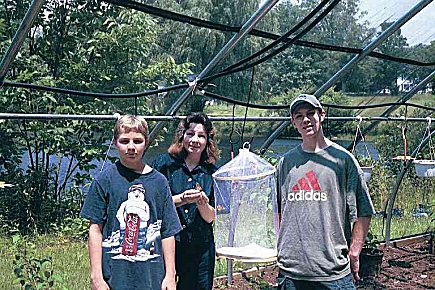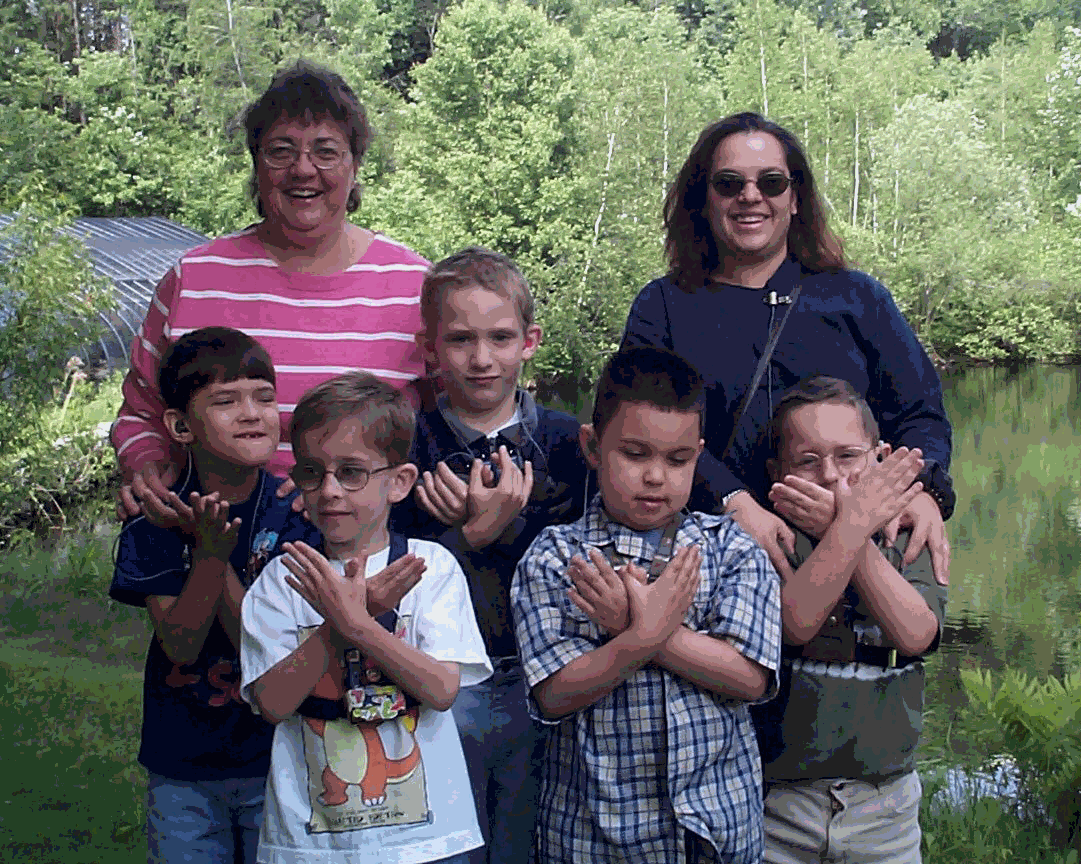A Day In The Life of a
Butterfly Breeder
by Melanie J. McCarthy : The Monarchy Butterfly Farm
This really is no ordinary day, but neither was yesterday or the day before. Waking up, a screen appears in front of my eyes rapidly portraying a list of what the priorities will be in the next hour and, of course, the rest of the day. It may be--actually it most likely will be-- that my smooth white, yellow and black Danaus plexippus larvae will be enjoying breakfast long before I do. Thinking about what will come before me, I am thankful that my two children, Evan, age 13 and Ryan, age 18, are well prepared to cook for themselves and get off to school this morning. What is different about today is that it is one day out an approximately 180-day period, which we lovingly and sometimes wearily refer to as "butterfly season".

Melanie and family
Our farm, aptly called The Monarchy, is set atop Wilbraham Mountain in the Pioneer Valley of Western Massachusetts. Having re-located here from a less rural setting in town just two years ago, we are fortunate to have the perfect setting for a butterfly farm. Our five-acre property, replete with a two-story barn-garage, room to plant milkweed fields and plenty of room to have constructed a 30 by 96-foot enclosed butterfly exhibit next to our pond, is exactly what was needed to accommodate us. This last move was the final stop in searching for the perfect spot to raise our lepidoptera and the final realization of our dream. Often I think about how it all began--with a shy, young boy's interest in lepidoptera.
Terry Terbush, my husband, always had a passion for butterflies - a passion this family would later share with as many people, young and old alike, as possible. Since childhood, he watched them, chased them, and tirelessly studied the various species. When he was a youngster in Webster, New York, his Little League coach once remarked that he'd be a much better player if he caught fly balls instead of butterflies in the outfield. Many years later, when our first son, Ryan entered school, Terry would volunteer his time amidst a renewed passion, to teach little ones in the classroom about the metamorphosis of both butterflies and moths, something that he continues to do. Now, ready to begin the tasks at hand, I gaze at the 800 larvae set before me and I begin my task. Asclepias syriaca, better known as common milkweed, leaves, picked earlier and thoroughly sterilized with a grain alcohol/water solution, are piled before me.
Since about 75% of my larvae, in the spring, are raised in special sterilized plastic and net covered containers, I must clean and sterilize those containers at feeding time which is twice a day. The other 25% are being raised outside within sleeves on Asclepias curassavica which is now just beginning to be voluminous outdoors in our fields. Toward the middle and end of the season, much of our butterflies will be raised outdoors. Keeping in mind that there are advantages to indoor rearing versus outdoor rearing and vice versa, I always have a sizable brood being raised indoors as well as outdoors. Larvae outdoors is always subject to the preying of other insects and birds! However, I know, if one has the space, outdoor rearing is very desirable because it mimics nature. While completing this 5-hour task, other responsibilities are not overlooked and I must keep my mind and hands busy with those simultaneously.
Newly emerging Monarchs, typically around 11 a.m. each morning, are being watched to be sure they emerge with room and are assisted if they occasionally fall from their precarious perch on the casing of the empty pupa. Egg laying almost exclusively takes place indoors in a four by three and half foot illuminated cage. This is to better control the humidity, temperature, lighting and cleanliness of the area. It is time to hand feed my gravid females, replace their nectar with fresh nectar or some other special treat for the day, mist so that the leaves of the plants stay fresh and the wings of the butterflies stay strong. I take a few moments to delight and stand in awe of these powerful females whose basic mission is to insure survival of the species! Indoors, newly laid eggs are collected after 24 hours and sterilized using a specially developed solution which kills bacteria and dissolves the O.E. (Ophryocistis Elektroscirrha) spore, a harmful protozoan that if left unchecked can be devastating to butterflies.
 Terry Terbush |
The small number of eggs laid in my outdoor exhibit area are not sterilized although the scales of the parents of those butterflies released in this area will have been checked, prior to mating, under the microscope for the O.E. spore. We have found that when rearing outdoors, the eggs, larvae, adults and plants are continuously cleaned by the elements of the weather and have a reduced risk of disease, just as they would in the wild. As an added precaution, however, every adult used in production is checked under a microscope and then another 10% of our general population are randomly checked, once a week, for the presence of the O.E. spore. With these safeguards in place, we rest assured that all of our livestock will be healthy and vibrant. As with any livestock industry, we know disease will bring operations to a full halt and possibly closure.
After sterilization, the eggs are placed in airtight containers to hatch. As the larvae emerges from the egg, they are carefully "brushed" onto milkweed. As I continue to work, I hear my two employees, Judy and Matt, arriving. Thank goodness. Judy will relieve me of the laborious task of feeding the larvae and sterilizing the containers. Her love of nature and wildlife is apparent as she often takes larvae home for "fostering" in the same way she "fosters" abandoned dogs and puppies. Matt, a life-long butterfly and moth enthusiast and an Environmental Science major at the University of Massachusetts will tend to outdoor tasks. Before going outside for the day, he relates a story about his third grade Science Project in which he researched and reported on various species of moths and butterflies from his collection. He seems proud of this.
Given what seems like a good opportunity, I talk about a recent Science Fair project completed by my own son, Evan in which he hypothesized, studied and reported on color attractants for the Painted Lady Butterfly. I am so proud of all his hard work! Highlights of Matt's day will include going out to the exhibit area to replenish nectar supplies, rotate, trim, water and fertilize plants and, of course, check on our insect control squad, two gorgeous Chinese Button Quail. Matt has graciously accepted to share duties with my husband in the roles of lecturing lepidopterists during our exhibit hours. They will present programs on the lifecycle as well as migration habits of the Monarch butterfly to inquisitive children and adults.

Visitors from the Willie Ross School for the Deaf
Today, Matt will observe a program being presented to hearing impaired children and 3 staff members, including an interpreter, from the Willie Ross School for the Deaf, which is located in Longmeadow, Massachusetts. I take time out from my own schedule to sit back and listen to my husband's presentation. What a pleasure! Beforehand, I remind Terry that his dry sense of humor may not be appropriate with these children since they rely heavily on visual gestures. He heeds my words of caution and is very animated, indeed! It turns out to be a very valuable program both for the children and the adults, staff included. With a cage full of Morning Cloaks, we allow the children to carefully release them in our exhibit area. Of course, the butterflies show off their acting ability first, playing dead, then spring to action and fly off. It is a remarkable moment for each child. We are grateful to serve this school for a second year and look forward to their visit next year.
As the day wears on my oldest son Ryan comes home from school and assumes the task of transplanting milkweed. He, also, has a childhood story to tell. He shows us the story he and his dad wrote in 1989 for the magazine published by The Young Entomologist Society. His contribution to the story related to what kinds of unusual things can happen when you are searching for butterflies. We enjoyed hearing about his encounter with a porcupine, how he captured two Viceroys and Skippers, letting them go a short time later and how he especially liked looking at the colors, shapes and patterns of the wings of the butterflies. I guess I can say we are a family of "lepidopterists".
We finally break for lunch and I sneak away to return phone calls. A bride asks about our shipping policies. Reviewing our careful packing and shipping procedures with her, I explain how each butterfly is hand-fed and exercised prior to packing. Then, the butterfly is carefully placed in an envelope just large enough for its body to be comfortable in the resting position but snug enough to protect its wings against damage. Boxes for shipping are padded and fit into a second box with insulating material and ice packs between both, all insuring protection against temperature extremes, drop shock and any type of compression injury. I further explain that shipping of the butterflies across state lines, for release, is regulated by the USDA which issues permits under strict guidelines that assure releases only take place in states that have appropriate habitat.
Hanging up, I hear my friendly mail carrier in the driveway. She "toots" to let me know the mail has arrived. I find an envelope containing a thoughtful note from a recent client. It reads: ". . . .the Monarchs arrived as you said they would. That same night just before dinner, all fifteen of us gathered outside and I handed everyone a little envelope and told all to be very careful as a living creature was inside. On the count of 3, we opened the envelopes and sent the Monarchs on their way. It was a sight to behold. Some guests from the hotel as well as staff members came out to watch the opening. The next morning, there was still one flying around. Thank you for helping to make our 50th more special than it was. It will be remembered for many a year. Thanks again, from Bernice and Don Murphy, Pelham, New Hampshire."
Finally, I walk down to my exhibit and flight area. It is about 1 hour before dusk and many of our species are still flying. I watch a Monarch glide gently to sip from a supply of nectar within the flower of a penta. Spicebush are engaging in mating rituals and chasing one another, stopping on the floor of the exhibit looking for minerals among the stone pebbles which are still wet from an earlier watering. A handsome male Zebra Longwing patiently awaits, while hovering, the emergence of a female still encased in her pupa. Approaching too closely, I startle a Black Swallowtail who gives his wings a powerful downbeat and lifts off his perch to seek another spot to nectar. Sorry! Amidst of all this is the sound of a brook just outside the door, the emerging sounds of the evening birds and the trilling sounds of night- calling insects. The pond is still and quiet, although I know the visiting Great Blue Heron is there, somewhere. This was, indeed, a good day. No, a splendid day! End July 2000.